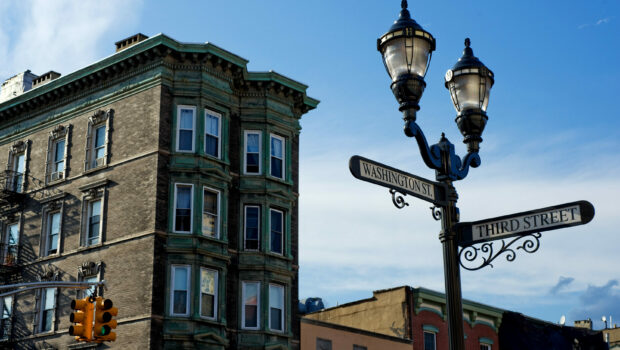
RAIN FALLS, HOBOKEN FLOODS: Mayor Defends Flood Mitigation Efforts in Wake of Fay; Labels Sewer Replacement ‘Impractical’
On Friday, Tropical Storm Fay made landfall in Little Egg Harbor and rolled up the New Jersey coast, barreling into Hoboken and dumping tremendous amount of rain in a short amount of time. As a result, streets and homes flooded with frightening speed, and motorists were trapped in floodwaters while homeowners we’re pumping out lower levels in a number of locations throughout the city.
Saturday evening, Hoboken Mayor Ravi Bhalla issued a statement on the impact of Tropical Storm Fay, and the status of the City’s flood mitigation strategies.
Now we’re pushing cars out here. @hMAG @ABC7NY @CityofHoboken @thehobokengirl #hoboken pic.twitter.com/ihpmibDeMZ
— Brandon Williams (@bjw5002) July 10, 2020
“[Friday], much of the tri-state area saw the heaviest flooding event since the Cinco de Mayo storm in 2017. In Hoboken and across the entire region, streets and roads were flooded, especially in low-lying areas. Hoboken received more than three inches of rain in six hours, with the peak 15-minute interval of the storm having a rate of 1.96 inches of rain per hour. Tropical Storm Fay was the equivalent of a 50-year storm; in other words, a storm that has a 2% chance of happening in any year,” said the Mayor.

ABOVE: Flooding on 10th & Clinton Streets—July 17, 2019 | Jules Ferrer photo
In July of 2017, remnants of Hurricane Barry hit Hoboken, wreaking havoc on the city’s streets—in many of the same areas impacted on Friday by Fay. Meanwhile, Fay had brought flooding to locations throughout Hoboken that hadn’t previously seen such an impact since the days of Irene or Sandy. Of course Sandy brought about the major initiatives for Hoboken’s floodwater mitigation program, with Rebuild By Design bringing nearly a quarter of a billion dollars into the city for the purposes of combating events like we saw on Friday.
“During Tropical Storm Fay, our two flood pumps covering the Northwest and Southwest parts of the City were in operation, and pumped out at least 12 million gallons of water from our streets during and after the storm. Our resiliency parks – including the Southwest Park and 7th and Jackson, stored over 185,000 gallons of water, that was released once the storm was over,” said Bhalla. “While the pumps were fully functional, what exacerbated flooding during certain times was the fact that the heaviest rain intensity occurred during and right after high tide, which prevented some of the water from flowing to the flood pumps. The flooding we saw yesterday could have been much more damaging, with the water not receding as quickly had the flood infrastructure with our flood pumps and resiliency parks not been in place.”
By the sky club in #Hoboken @adamxdaleo pic.twitter.com/OSZNoh2x9u
— HobokenGirl.com (@thehobokengirl) July 10, 2020
The City has traditionally defended its ongoing efforts to fight flooding in Hoboken as works in progress. Over the nearly eight years since Sandy, members of the administration have received accolades and been featured in international news stories for the work being done here. While pumps, rain gardens and resiliency parks are all part of an ongoing effort to protect Hoboken residents from just such occurrences, flooding continues. While all these efforts are made to fight flooding in a city that sits precariously near sea level, significant residential development continues.
7 Seventy House is defying the odds during the COVID-19 pandemic in Hudson County’s rental market, surpassing 70% leased https://t.co/LiF71WsZWl @Bijouproperties #CRE
— NJBIZ (@NJBIZ) June 3, 2020
Directly adjacent to the resiliency park at 7th & Jackson is a 14-story 424-unit luxury apartment building at the base of the Palisades. That land is historically swampland that was carved out by the mouth of the Hudson River—every so often, the river returns to reassert itself. Further upstream from that location, yet another development project is currently taking shape along the city’s Western Edge.
One of the cornerstones of Hoboken’s flood mitigation initiative is the 5-acre northwest park currently under construction, built on a contaminated industrial site, which will be capable of holding 2 million gallons of rainwater runoff. In February 2019, the City pledged that it would fix chronic, costly flooding near 9th & Madison Streets next to ShopRite, one of Hoboken’s principal grocery stores. Last Friday, that area saw some of the worst flooding in town, as the densely populated city still remains perilously exposed to significant rain events.
Flooding outside ShopRite in #Hoboken #TropicalStormFay!@hMAG @thehobokengirl @News12NJ @ABC7NY @NY1weather @StormTeam4NY @WeatherNation @MikeBWeather pic.twitter.com/wEUp62rGXl
— Weather Fan (@fan_weather) July 10, 2020
“I completely understand some of the frustration from those who may have been caught on streets with elevated water or had flooding in their homes as a result of the tropical storm. To be completely straightforward–given Hoboken’s low-lying typography and location right next to the Hudson River, even with unlimited funding, we are unlikely to solve the most severe of storms (50-year flooding event or worse), like we experienced yesterday,” said Bhalla. “Most of Hoboken, especially the western part of the City, was developed on land that was previously tidal wetlands from the Hudson River. NHSA estimates that to prevent the most severe of flooding events, like the storm we saw yesterday, we would need to replace our entire sewer system, which would cost an estimated $3 billion. Needless to say, this is an impractical solution.”
Yet Bhalla still makes the case for continued investment in flood mitigation.
“But what we can do, and what we have been doing, thanks in large part to our strong partnership with the leadership and commissioners at NHSA, is to continue with investing in smart, sensible flood infrastructure that will help alleviate the majority of flooding events. As we’ve communicated about previously, under construction right now is another resiliency park in Northwest Hoboken, that will have the ability to store up to 2 million gallons of rainwater when complete, and further mitigate flooding in Northwest Hoboken,” said Bhalla. “And, our $230 million Rebuild by Design project is one of the most innovative projects in the entire state to eventually protect from storm surge from the Hudson River through above ground amenities, including a public park. We’re continuing to build rain gardens, cisterns, and integrate flood infrastructure into a number of our City projects as a matter of policy. In the past few years, both of our parks in Southwest Hoboken and at 7th and Jackson have come online that include green infrastructure and underground detention systems to withhold hundreds of thousands of gallons of rainwater.”
Lake Madison #hoboken pic.twitter.com/WlJnrjP4t1
— Joseph Cristofaro (@JoeCristofaro) July 10, 2020
As these 50-year flooding events continue year, after year, after year, after year, residents continue to wonder whether rain gardens, resiliency parks and other investment in mitigation will be able to keep pace with ongoing climate and development strains in Hoboken.
“As the statistics and facts show, Hoboken’s two new flood pumps, along with our resiliency parks have successfully prevented flooding during many storms, and regular rainfall events that would have previously caused flooding on our streets,” said Bhalla. “While we are compiling recent statistics with NHSA, during the first 10 months since the H-5 pump came online (the H-1 pump went online in 2011), the flood pumps together helped prevent flooding during 88% of rain events, including two heavy rainstorms that had peak intensities of 1.5 inches of rain per hour. Again, we won’t be able to prevent the most severe of storms like Tropical Storm Fay, but we are making important progress.”
Hurricane season in the North Atlantic runs from June 1 through November 30, every year.
#Hoboken #Flooding 8th & Willow https://t.co/m4zflrrfYr
— hMAG (@hMAG) July 10, 2020
***

 Previous Article
Previous Article Next Article
Next Article 2017 HOBOKEN MAYOR CANDIDATE SURVEY
2017 HOBOKEN MAYOR CANDIDATE SURVEY  THE GUNS FELL SILENT: Hoboken Veterans Day Commemorates the Centennial of World War I — PHOTO GALLERY
THE GUNS FELL SILENT: Hoboken Veterans Day Commemorates the Centennial of World War I — PHOTO GALLERY  Hoboken Breaks Ground on Previously Encapsulated Industrial Site to Build Northwest Resiliency Park
Hoboken Breaks Ground on Previously Encapsulated Industrial Site to Build Northwest Resiliency Park  Hoboken’s NoVia (North of the Viaduct): Not Just Viable — Vivacious
Hoboken’s NoVia (North of the Viaduct): Not Just Viable — Vivacious  REINVENT: How Hoboken Small Businesses Can Pivot Their Strategy
REINVENT: How Hoboken Small Businesses Can Pivot Their Strategy  ON THE WATERFRONT STORYTELLING SERIES: Adam Wade and Carla Katz Bring NYC Storytelling Scene to Mile Square Theatre—FRIDAY, MAY 4
ON THE WATERFRONT STORYTELLING SERIES: Adam Wade and Carla Katz Bring NYC Storytelling Scene to Mile Square Theatre—FRIDAY, MAY 4  ATTACKING LIFE: U.S. Olympic Fencer Dagmara Wozniak Brings Grace to Combat Sport
ATTACKING LIFE: U.S. Olympic Fencer Dagmara Wozniak Brings Grace to Combat Sport  THE FIFTH COMMANDMENT: Fleeing Nazi Persecution, Manfred Gans Fought His Way Back to Liberate His Own Family
THE FIFTH COMMANDMENT: Fleeing Nazi Persecution, Manfred Gans Fought His Way Back to Liberate His Own Family